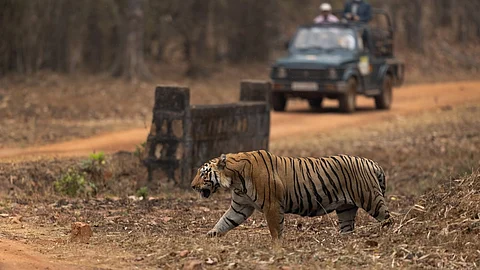
- Destinations
- Experiences
- Stay
- What's new
- Celebrating People
- Responsible Tourism
- CampaignsCampaigns
- SubscribeSubscribe
- Buy Now

Nestled in the valley of the Wardha River in the Wardha district of Maharashtra, the Bor Wildlife Sanctuary is the smallest tiger reserve in the country. According to sources, there are approximately 15 to 20 tigers inside the country's smallest tiger reserve. There were just four when it was officially recognised as a Tiger Reserve in 2014.
Bor's transformation into a Tiger Reserve took time and did not happen overnight. Until 2014, it was known as Bor Wildlife Sanctuary and was home to a variety of wildlife. At present, the reserve is 138.12 km sq. in size.
The Bor Tiger Reserve is well-known for its abundant biodiversity and is a vital habitat for a wide variety of animals, including Bengal tigers.
In 1970, Bor was recognised as a wildlife sanctuary due to Bor River's major contribution to the success of the surrounding landscape as a biodiversity hotspot. Following the inception of Project Tiger and the recognition of other reserves in Maharashtra, Bor was momentarily forgotten by the general public; in fact, very few tourists ever visited the sanctuary. Slowly but surely, modern techniques for camera trapping and the mapping of tiger dispersal patterns shed new light on Bor.
It was later discovered that this park was connected to larger and more well-known tiger reserves like Pench, Tadoba, Melghat, and Satpura via forested patches. Given that tigers roam over extensive territories, the expanse of Bor and its connecting routes play a crucial role in ensuring gene flow and fostering robust reproduction among tigers in this region.
Green Cover: The Sanctuary region is home to a variety of dry deciduous forest types. Among the several species are tarot, gokhru, tendu, teak, and bamboo.
Mammals: The reserve is home to a variety of mammal species, such as the Bengal Tiger, Indian Leopard, Sambar, Chital, Monkey, and Indian Bison. The Bengal Tigers are the primary attraction for visitors here. Data from the Wildlife Institute of India indicates that before 2014, the Bor sanctuary and its surroundings had a population of only six to seven tigers. However, these numbers have risen, with the current count reaching approximately 16 tigers.
Avifauna: Some 160 different species of birds flutter and fly the skies over Bor. They come from 46 families representing sixteen separate orders. Furthermore, there are nine endangered bird species, including the Indian Vulture, Long-billed Vulture, Egyptian Vulture, White-rumped Vulture, Red-headed Vulture, Lesser Kestrel, Pallid Harrier, Greater Spotted Eagle, and the Eastern Imperial Eagle, and ten migratory bird species.
Reptiles: There are 26 species of reptiles found in the Bor Tiger Reserve, six of which are endangered. Indian cobras, chequered keelbacks, monitor lizards, Indian rat snakes, Indian rock pythons, and Russell's vipers are among the endangered species.
Bor has two safari entry points, Bordharan Safari Gate and Adegaon Safari Gate. The official Maharashtra tourism website allows you to make online reservations for tiger safaris in the Bor tiger reserve.
On a given day, twenty cars are permitted from the Bordharan safari gate and fifteen vehicles from the Adegaon safari gate.
Take note that the Bor Tiger Reserve is closed to tourists every Monday. Thus, plan your Bor safari itinerary wisely.
For information regarding where to stay, click here.
In order to reach the Bor Tiger Reserve, one must continue on the Wardha-Nagpur road via MSH3 and turn north at Seloo for Hingni. From Hingni, you can go straight to the Bor Dam visitor centre.
By Air: Nagpur's Dr Babasaheb Ambedkar International Airport is the closest airport to Bor Tiger Reserve. From here, the sanctuary is 80 kilometres away.
By Rail: Wardha, the closest railhead, is located at a distance of 35 kilometres.
By Road: The Hingni bus stand is a mere distance of 5 kilometres from the reserve. Buses to and from Bor Wildlife Sanctuary arrive and depart frequently from this location.
